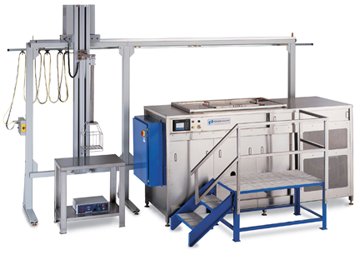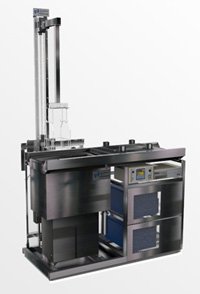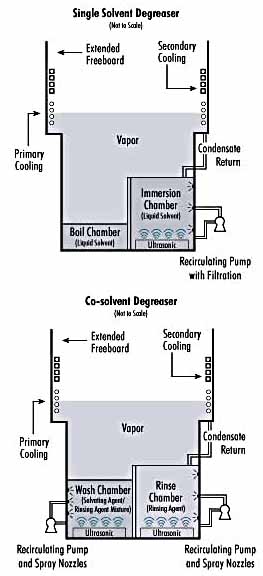Solvent
Vapor Degreasers |

Greco Brothers
Solvent Vapor Degreasers
are designed and built to provide years of trouble-free operation, utilizing virtually any of the non-flammable degreasing solvents currently on the market. Our systems can be configured to operate with chlorinated solvents and n-propyl bromide to remove heavy grease, oils, and compounds from heavily soiled industrial parts; or with the new HFE and HFC blends used in precision cleaning applications.Greco Brothers solvent
vapor degreasing systems
meet recent EPA and NESHAP guidelines and include innovative features, like sealing covers,automated shut-down cycles, and early malfunction detection:all designed to make operating with the new solvents cost-effective and trouble-free.How Vapor Degreasers Work
Solvent degreasing
involves the exposure of a work piece to pure solvent vapors released by a boiling solvent. The work piece is usually suspended in the vapors just above the boiling solvent. When the warm vapors touch the comparatively cool work piece, a condensing action occurs which dissolves the contamination and flushes it away as it runs off the part. This cleaning action will continue until the work piece and the solvent vapor are the same temperature. Beyond this basic procedure a number of additional cleaning operations are often used, including immersion rinsing, ultrasonic cleaning, spray under immersion, and part agitation.The degreaser styles depicted here can operate with n-propyl bromide, chlorinated solvents, and the new fluorinated solvents like HFE's, HFC's and their azeotropes.
Degreasing Applications
Although water-based cleaning systems are effective in many applications, some aspects of aqueous-based cleaning can make it impractical or unusable for certain cleaning applications. Solvent degreasers are used for removal of petroleum based oil, grease, wax and other stubborn solvent-soluble soils from nearly any non-porous surface. They are also very effective at precision-cleaning highly sensitive parts contaminated with dust, fingerprints, and other air-borne contaminants. Vapor degreasers are commonly used to clean, machined parts, electrical and electronic subassemblies, intricate metal and plastic components, artificial joints, lenses, and a wide variety of other products prior to further processing, assembly, inspection, or packaging. Nearly any part can be cleaned in a solvent degreaser without concern for quality control issues like part oxidation, effective drying, and water spots, because no water is used in the process.
Safety Controls & Solvent Retention Systems
All solvent degreasers depicted here are designed to meet or exceed the latest EPA guidelines for safety and solvent retention.
Safety Controls:
Every style includes safety interlocks which interrupt the machine's operation if the system runs low on liquid, high on vapor, or if the temperature in the cleaning compartment rises significantly above the boiling point of the solvent. Additionally, power to the spray pump will be interrupted if the vapor level drops by more than four inches.
Solvent Retention Systems:
One of the prime objectives in degreaser-design is solvent efficiency. Retaining the vapors within the machine is important for worker safety and economic operation. Several factors effect the overall efficiency of the system:
The Primary Cooling System:
A multiple pass perimeter cooling coil is used as a heat exchanger to condense the vapors, creating a sustainable vapor zone. The primary coil must be maintained at a temperature that will cause the vapors to readily condense. This function can be performed by directly refrigerating the coil, or by passing chilled water through it.
On Refrigerated Machines:
On systems with integral refrigeration, a direct-expansion refrigeration system is attached directly to the primary cooling coil. The refrigeration system operates continuously; removing the precise amount of heat required to ensure proper vapor condensation.
On Water-Cooled Machines:
On water-cooled vapor degreasers, a coolant flows through the primary cooling coil. If a constant supply of cool water is available, the machine can operate on water alone. More commonly however, to save water and to assure constant temperature, a combination of coolant and water is circulated through a refrigerated water chiller. The water chiller may be dedicated entirely to one degreaser, or it may be serving the cooling requirements of other equipment simultaneously. Water-cooled degreasers that are connected to a water chiller perform as efficiently as refrigerated machines.
Secondary Cooling System:
The secondary cooling system consists of an additional cooling coil that is mounted directly above the primary cooling coil and maintained at sub-zero temperatures, creating a cold blanket of air which further reduces solvent consumption. EPA guidelines call for a freeboard chiller on vapor degreasers containing trichloroethylene, perchloroethylene, or methylene chloride. Given that a properly-designed freeboard chiller will reduce evaporative losses by 30% to 45%, the cost of a freeboard chiller can easily be justified as a solvent-saving measure with a short payback period; regardless of whether the degreasing fluid is a chlorinated solvent or a newly developed fluorinated solvent.
Freeboard Ratio:
Freeboard is the area within the machine above the vapor zone. The freeboard ratio compares the width of the of the top opening of the machine to the freeboard height (the height of the area above the top of the vapor zone. Higher freeboard ratios have been demonstrated to aid in solvent retention. All standard Greco Brothers Vapor Degreasers include freeboard ratios between 1.0:1 and 1.25:1. Freeboard ratios between 1.25:1 and 1.5:1 are offered to customers using HFE's and HFC's if ceiling height at the installation site permits.
Drop-Seal Cover:
Unlike common sliding covers that leave gaps around their perimeter, this unique cover is designed to roll into place and seal the work chamber from the atmosphere; virtually eliminating evaporative losses during downtime.
The Three Basic Designs
Vapor Spray Degreasers
![[Vapor Degreaser diagram]](images/cvddiasmall.jpg) |
The Greco Brothers vapor-spray degreaser is a one compartment cleaning system with the vapor zone located directly above the boiling solvent. This unit is designed for cleaning applications that require suspension in pure solvent vapors only. Typically, the work piece is lowered into the vapor zone and held there until condensation ceases. If necessary, it is then sprayed with freshly distilled solvent to remove oil, chips, solder flux or other soils. Spraying the work piece also cools it slightly, causing the vapor to begin condensing on the work piece again. Once condensation ceases again, as the work piece reaches the temperature of the boiling solvent, the cleaning process is complete. The work piece is then raised into the freeboard area where it is held until it is dry. Standard work chamber sizes range from 25" x 14" x 22" to 60" x 30" x 36". Custom sizes are also available to meet the requirements of nearly degreasing application. |
Immersion/Vapor Spray Degreasers
![[Immersion Degreaser diagram]](images/cviddiasmall.jpg) |
Parts contaminated with particularly stubborn soils, or very light-weight parts that reach the vapor temperature very quickly may not be completely cleaned in the initial vapor stage. When a vapor immersion is not adequate for a particular cleaning application, an immersion/vapor spray design is suggested. The cleaning cycle of the immersion vapor spray unit is similar to that of the vapor spray unit, except that after the vapor stage, the part is immersed in the warm liquid solvent sump. This step provides additional cleaning and also lowers the temperature of the part. After the liquid immersion stage, the part is then raised back into the vapor zone to allow for final vapor rinse prior to removal from degreaser. Standard work chamber sizes range from 12" x 14" x 12" to 28" x 20" x 20". Custom sizes are also available to meet the requirements of nearly degreasing application. |
Ultrasonic Immersion/Vapor Spray Degreasers
![[Ultrasonic Degreaser diagram]](images/cvuddiasmall.jpg) |
Ultrasonic degreasing offers advantages for the most stubborn contaminants and is commonly used for cleaning applications like those listed below:
The ultrasonic vapor degreaser incorporates the same features as the immersion/vapor spray degreaser, with the addition of ultrasonic agitation in the liquid rinse sump. The cleaning cycle remains the same, with the work piece being suspended in the ultrasonic sump for the required time. Standard work chamber sizes range from 12" x 14" x 12" to 28" x 20" x 20". Custom sizes are available with surprisingly short lead times. |
High Performance Options
Programmable Lifts
|
Programmable lift systemsare available for all degreasers. The use of a programmable lift system eliminates the need for an operator to process parts through the cleaning cycle. The operator loads the parts on the part carrier and presses the "Start" button. The lift automatically runs through the programmed cleaning cycle and returns the cleaned parts to the unload area.On the simplest programmable lifts, generally offered for use with smaller degreasers, the part carrier is loaded and unloaded at the top of the machine. When process requirements demand, a dedicated load and unload station can be located at floor level adjacent to the machine. A variety of control packages are available for these systems, ranging from a function pad with a graphic text-screen to a color touch-screen. |
Co-solvent Degreasers
|
Our standard two-compartment degreasers are configured as single-solvent systems. Parts can be cleaned with
the single-solvent degreasing method with either a pure solvent,
or more commonly, with a solvent azeotrope. In a single solvent system, the work piece is
normally suspended in the vapors directly above the wash compartment,
where it is exposed to the pure solvent vapors generated by the
boiling solvent below. When the warm vapors touch the comparatively
cool work piece the vapors condense into liquid and dissolves the
contamination on the part surface. The contaminant is then and flushed away as it pours off the part. This
cleaning action continues until the work piece and the solvent
vapor have reached the same temperature. The work piece is then
immersed in the somewhat cooler rinse sump, where any residual
contaminants left on the part are dissolved. For particularly
stubborn contaminants, ultrasonics are added to this compartment.
After immersion cleaning, the part is raised back into the vapor
zone, where a final condensate rinse takes place.
Co-solvent degreasers, sometimes calledduo solvent degreasersoperate somewhat differently. They use a unique combination of two distinct types of non-ozone-depleting cleaning agents.This system is sometimes used for flux removal, and is most appropriate for applications where pure fluorinated solvents or their azeotropes are not aggressive enough to dissolve the contaminant. The cleaning process is similar to single-solvent degreasing, except that in the initial cleaning stage, the part is completely immersed in the wash compartment. A solvating agent in the wash sump dissolves contaminants from the work piece The liquid in the wash sump is constantly filtered to remove any solid particulate. The part is then removed from the wash chamber and immersed in the rinse compartment, which contains pure liquid solvent. It is then raised into the vapor zone, where it receives a final vapor rinse. Ultrasonics may be provided in either or both compartments, depending on the cleaning application. Additionally, the solvating agent can be specifically formulated for the contaminant being removed and the ratio of solvating agent to fluorinated solvent can be adjusted to affect the temperature and effectiveness of the wash compartment.Because this system uses two chemistries with different boiling temperatures, it's operation tends to be somewhat more complicated than that of a single-solvent machine and is normally supplied with an upgraded control package. |
| Greco Brothers Incorporated | |
| 1 Greco Lane, Providence, RI 02909 | Phone: 401-421-9306 | Fax: 401-274-8910 | |
www.grecobrothers.com | info2@grecobrothers.com |




